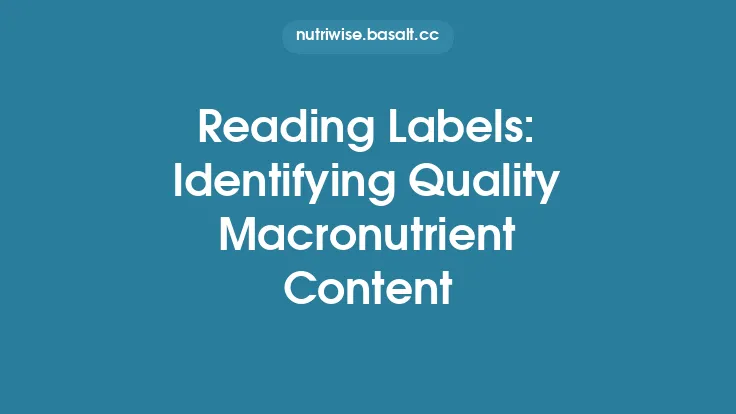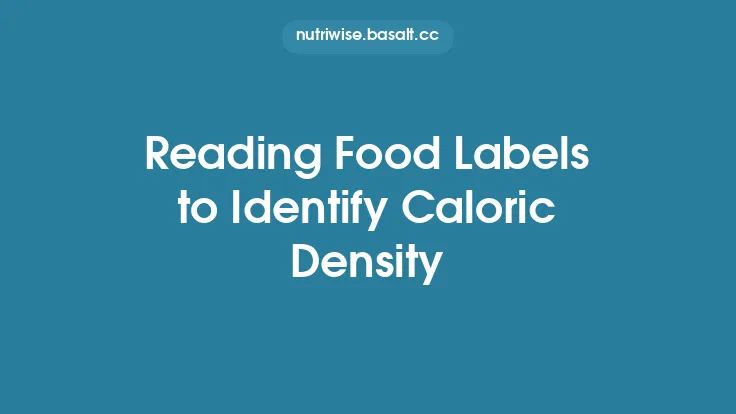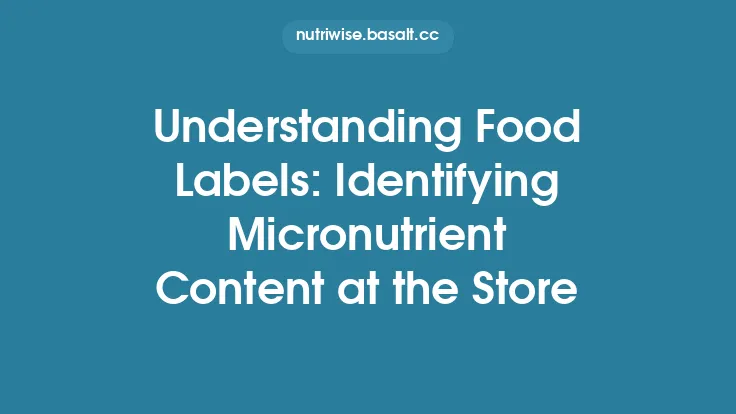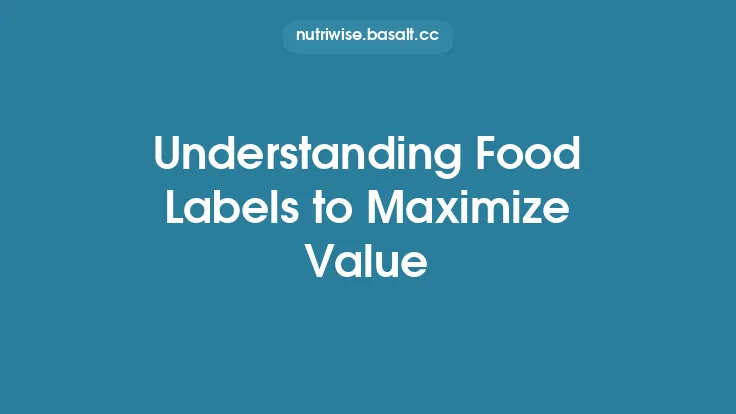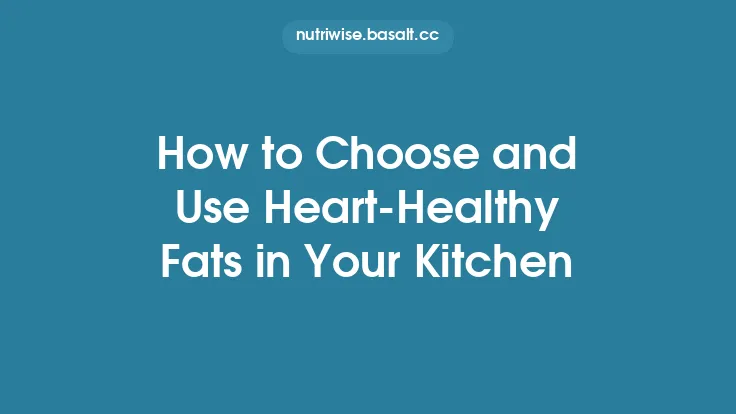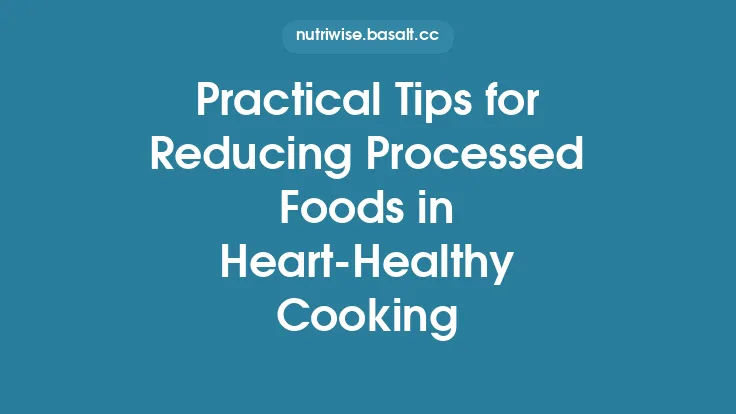When you walk down the grocery aisle, the most powerful tool you have for making a smart choice about the fats you consume is the food label. While the bright colors and marketing claims can be tempting, the Nutrition Facts panel and ingredient list hold the factual data you need to differentiate truly beneficial fats from those that may be hidden, unhealthy, or even deceptive. Understanding how to read these labels—what to look for, what the numbers mean, and how manufacturers are allowed to present the information—empowers you to build a diet that supports long‑term wellness without falling prey to “healthy‑fat” hype or concealed trans fats.
The Nutrition Facts Panel: Where the Numbers Live
Total Fat and Its Sub‑Categories
The first line under “Calories” is “Total Fat.” This figure includes all fatty acids present in the product, measured in grams per serving. Directly beneath it, you’ll find the breakdown into:
- Saturated Fat – often limited in dietary guidelines because of its association with elevated LDL cholesterol.
- Trans Fat – listed separately, even if the amount is zero.
- Polyunsaturated Fat and Monounsaturated Fat – sometimes displayed, especially on products that want to highlight their “good” fat content.
When the panel includes the sub‑categories, you can quickly gauge the quality of the fat profile. A product with a modest total fat amount but a higher proportion of unsaturated fats (poly‑ and mono‑) is generally a better choice than one where most of the fat is saturated or trans.
Understanding the % Daily Value (%DV)
The %DV column is based on a 2,000‑calorie reference diet. For fat, the FDA sets the daily value at 78 g. If a serving provides 15 g of total fat, that translates to roughly 19 % DV. Use the %DV to compare products of different serving sizes: a lower %DV for saturated fat and trans fat is preferable, while a higher %DV for unsaturated fats can be a positive signal.
Serving Size vs. Package Size
Manufacturers are required to list the serving size that they used to calculate the nutrient values. Frequently, the package contains multiple servings, which can inflate the perceived “low‑fat” claim. Always multiply the per‑serving numbers by the number of servings in the package to understand the true intake you’ll get if you eat the whole item.
Ingredient List: The Hidden Narrative
Order Matters
Ingredients are listed in descending order by weight, from highest to lowest, before cooking or processing. The first few ingredients give you a clear picture of what the product is primarily made of. If “vegetable oil,” “hydrogenated oil,” or “partially hydrogenated oil” appear near the top, the product is likely high in added fats.
Key Phrases That Signal Unhealthy Fats
| Phrase | What It Means |
|---|---|
| Partially hydrogenated | Indicates the presence of industrial trans fats. Even if the label lists 0 g trans fat, the FDA allows this claim only if the amount is <0.5 g per serving. |
| Hydrogenated | Fully hydrogenated oils are solid at room temperature and contain no trans fat, but they are high in saturated fat. |
| Interesterified | A newer processing method that rearranges fatty acids on the glycerol backbone. It can mimic the functional properties of trans fats, and health implications are still under investigation. |
| Shortening | Often made from partially hydrogenated oils; check the ingredient list for “hydrogenated” or “partially hydrogenated” qualifiers. |
| Blended oil | May contain a mix of refined oils, some of which could be partially hydrogenated. Look for a detailed breakdown on the label or the manufacturer’s website. |
| Margarine | Traditionally made with partially hydrogenated oils, though many brands have reformulated. Verify the ingredient list. |
| “Zero trans fat” | This claim is permissible only if the product contains <0.5 g trans fat per serving. If the serving size is small, the total amount per package could still be meaningful. |
Hidden Sources of Fat in “Non‑Fat” Products
Products marketed as “fat‑free” or “low‑fat” can still contain significant amounts of fat if the serving size is artificially small. For example, a “fat‑free” snack that lists a serving size of 5 g may contain 0 g fat per serving, but a typical consumption (e.g., 30 g) could deliver 1–2 g of fat. Always calculate the actual intake based on how much you intend to eat.
Spotting Trans Fats When the Label Says “0 g”
The 0 g Threshold
U.S. regulations allow a product to list “0 g trans fat” if it contains less than 0.5 g per serving. This can be misleading because a package with multiple servings could still provide a non‑trivial amount of trans fat. For instance, a 10‑serving box of crackers with 0 g trans fat per serving could still contain up to 5 g of trans fat in total.
Cross‑Checking the Ingredient List
If you see any of the following terms, assume the product may contain trans fat, regardless of the 0 g claim:
- Partially hydrogenated oil (any type)
- Shortening (unless explicitly labeled as “non‑hydrogenated”)
- “Interesterified” fats (use caution)
Estimating Hidden Trans Fat
When a product lists “0 g trans fat” but includes partially hydrogenated oils, you can estimate the likely trans fat content by:
- Checking the total fat – If total fat is high and saturated fat is low, the missing fat may be trans fat.
- Looking at the serving size – Smaller serving sizes increase the chance that the <0.5 g per serving rule is being used to mask a higher total amount.
- Consulting the manufacturer’s website – Some companies provide a full fatty‑acid profile in their online nutrition facts.
Front‑of‑Pack (FOP) Claims: Decoding the Marketing Lingo
“Low‑Fat,” “Reduced‑Fat,” and “Light”
These claims are regulated but can be ambiguous. “Low‑fat” means ≤3 g of fat per serving, while “reduced‑fat” indicates at least a 25 % reduction in fat compared with the standard product. “Light” can refer to reduced calories, fat, or both, depending on the context. Always verify the actual numbers on the Nutrition Facts panel.
“No Trans Fat” vs. “Zero Trans Fat”
“No trans fat” is a stronger claim; it means the product contains no detectable trans fat, not even the <0.5 g allowance. “Zero trans fat” follows the same rule as “0 g trans fat” and may still contain trace amounts.
Health‑Star Ratings, Traffic Lights, and Nutri‑Score
These front‑of‑pack symbols provide a quick visual summary of overall nutritional quality, including fat content. While useful for rapid comparisons, they aggregate multiple nutrients, so a product with a favorable score could still contain hidden trans fats. Use them as a first filter, then confirm with the detailed label.
Practical Walk‑Throughs: Applying Label Literacy
1. Granola Bar
- Nutrition Facts: 8 g total fat, 1 g saturated, 0 g trans, 3 g polyunsaturated, 2 g monounsaturated.
- Ingredient List: “Whole grain oats, honey, brown rice syrup, canola oil, soy protein isolate, sea salt, natural flavor.”
- Analysis: The presence of canola oil (a source of monounsaturated fat) near the middle of the list suggests a modest amount of added oil. No hydrogenated oils appear, and the trans‑fat claim aligns with the ingredient list. This bar offers a relatively balanced fat profile.
2. Salad Dressing
- Nutrition Facts: 14 g total fat, 2 g saturated, 0 g trans, 10 g monounsaturated, 2 g polyunsaturated.
- Ingredient List: “Soybean oil, water, distilled vinegar, salt, sugar, mustard seed, spices, natural flavors, partially hydrogenated soybean oil.”
- Analysis: The inclusion of “partially hydrogenated soybean oil” is a red flag. Even though the label lists 0 g trans fat, the product can legally contain up to 0.5 g per serving. If the serving size is 2 Tbsp, a typical use of 4 Tbsp could double that amount. Consider an alternative dressing without hydrogenated oils.
3. Frozen Pizza
- Nutrition Facts: 12 g total fat, 5 g saturated, 0 g trans, 0 g polyunsaturated, 0 g monounsaturated (fat breakdown not provided).
- Ingredient List: “Enriched wheat flour, water, cheese (milk, cheese cultures, salt, enzymes), tomato sauce (tomatoes, water, salt, spices), partially hydrogenated vegetable oil, yeast, sugar, salt, spices.”
- Analysis: The presence of partially hydrogenated oil directly signals trans fat, despite the 0 g claim. The high saturated fat (5 g) also suggests a less favorable fat profile. Opt for a pizza that lists “olive oil” or “canola oil” without hydrogenated terms.
Tips for Consistent Success at the Checkout
| Action | Why It Matters |
|---|---|
| Always read the ingredient list first | It reveals hidden fats before you even look at the numbers. |
| Calculate the actual intake based on your portion | Serving sizes are often smaller than what you’ll actually eat. |
| Cross‑reference “0 g trans” with ingredient clues | The <0.5 g rule can mask meaningful amounts across a package. |
| Prefer products that disclose poly‑ and monounsaturated fats | Transparency indicates a focus on healthier fat sources. |
| Use a smartphone scanner or the brand’s website for full fatty‑acid profiles | Some manufacturers provide detailed breakdowns not required on the label. |
| Beware of “fat‑free” or “light” claims on highly processed foods | These can be marketing tactics that hide high sugar or refined carbohydrate content. |
| Look for “no partially hydrogenated oils” statements | This is a clear, regulated claim that eliminates industrial trans fats. |
Emerging Trends in Fat Labeling
Regulatory bodies worldwide are moving toward more granular labeling. In the European Union, mandatory “fatty‑acid breakdown” (saturated, monounsaturated, polyunsaturated) is becoming standard, and the United States is considering similar requirements. Additionally, QR codes on packaging can link directly to a full nutrient database, allowing consumers to see exact grams of each fatty acid, including any trace trans fats.
Staying informed about these developments ensures that you can continue to rely on the most accurate data available, rather than solely on front‑of‑pack marketing.
Bottom Line
Reading food labels with a focus on fats is less about memorizing numbers and more about developing a systematic approach:
- Start with the ingredient list to spot any hydrogenated or interesterified oils.
- Verify the Nutrition Facts panel for total fat, saturated fat, and trans fat, paying close attention to serving size and %DV.
- Interpret “0 g trans” claims through the lens of the <0.5 g per serving rule and the ingredient list.
- Cross‑check front‑of‑pack claims with the detailed panel to avoid being misled by marketing language.
- Apply real‑world calculations to the amount you actually intend to eat, not just the listed serving.
By consistently applying these steps, you can confidently select foods that provide beneficial unsaturated fats while steering clear of hidden trans fats and other less desirable fat sources. This label‑literacy empowers you to build a diet grounded in transparent, evidence‑based nutrition—exactly the kind of evergreen knowledge that supports lasting health.
